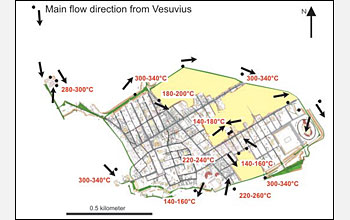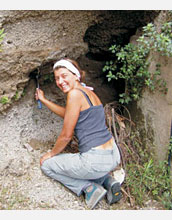All Images
Research News
Feverish Effort Under Way to Understand Mt. Vesuvius

Aerial view of the Somma-Vesuvius volcano. If a new eruption occurs, more than 700,000 people in the area could potentially be affected by pyroclastic flows.
Credit: Andrew Harris, University of Hawaii HIGP
Download the high-resolution JPG version of the image. (69 KB)
Use your mouse to right-click (Mac users may need to Ctrl-click) the link above and choose the option that will save the file or target to your computer.

Deposits from the A.D. 79 eruption in the archaeological site of Pompeii. Fallout and pyroclastic flow deposits were emplaced during events similar to the ones experienced during the 1980 eruption of St. Helens (in the insets).
Credit: Lucia Gurioli, University of Hawaii at Manoa; insets USGS/Cascades Volcano Observatory
Download the high-resolution JPG version of the image. (72 KB)
Use your mouse to right-click (Mac users may need to Ctrl-click) the link above and choose the option that will save the file or target to your computer.

This map shows how the city of Pompeii and its buildings caused changes in the direction and temperature of the pyroclastic flows that entered Pompeii during the A.D. 79 eruption. Our results show that the presence of the city caused the flow to move in different directions, such as moving along roads and around city walls. The presence of the city also influenced the flow temperature. The flows were cooled in places, although not to temperatures that would be comfortable for humans sheltering in the remains of the city. Imagine being in front of a ground-hugging cloud that is moving toward you at a hundred miles an hour or more, and it contains sand, rocks and bits of building, and (if that's not enough already) has a temperature of more than 100 degrees Celsius (212 degrees Fahrenheit).
Credit: Gurioli et al., 2005
Download the high-resolution JPG version of the image. (37 KB)
Use your mouse to right-click (Mac users may need to Ctrl-click) the link above and choose the option that will save the file or target to your computer.

Lucia Gurioli at the Oplontis archaeological site on Vesuvius collecting pumice from the A.D. 79 deposits that covered this Roman settlement.
Credit: Andrew Harris, University of Hawaii HIGP
Download the high-resolution JPG version of the image. (38 KB)
Use your mouse to right-click (Mac users may need to Ctrl-click) the link above and choose the option that will save the file or target to your computer.


